大同大學工業設計學系助理教授
Assistant Professor, Department of Industrial Design, Tatung University
Article of famous designers
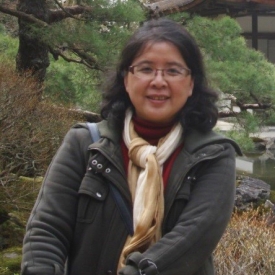
大同大學工業設計學系助理教授
Assistant Professor, Department of Industrial Design, Tatung University
Iremember when I was a student majoring in Industrial Design, the design ideasof "form follows function" and "function-oriented"coincided with the popularity of modernism, but I was deeply confused. SinceEasterners and Westerners are different, their design considerations shouldalso have differences. Looking for traditional oriental design thinking becamemy research subject in my masters and PhD theses. Through research of atraditional artifact, a red sleeping bed, I understood the creation system of traditionalcraftsmen and the behavior of users. I discovered that the creation model oftraditional Han Nationals was constructed in a circular model from "Tao(the Way.)," "Hsing (physical existence)," "Chi (concretething),” and "Hsiang (form)" (Fig. 1). This circular model is to finda problem and "phenomenon" through "observation," and toclarify the key points of this problem through "reflection"symbolized by Tao and ponder ways to solve the problem; then, slowly "shaping,"through brush and modeling, gradually constructing a form from the invisibleconcept; after repeated corrections, eventually forming a "Utensil"available for use. When people use these artifacts, through the structure andthe interpretation of the relationship between the objects and themselves, many"phenomena" are generated. These phenomena will affect"Tao." "Tao" here is symbolic of society configured by the"reflection of people." Therefore, in ancient China, the Creator wascalled "Saint." The creator needs to recognize the real world inaddition to making creations, and has a responsibility to society. Whileteaching at Tatung University, I have adopted this creation model to teachstudents in design and application.
Injust a few years of teaching experience, I have luckily taught some excellentstudents. The excellent performance of these students allowed Tatung Universityto continuously win several international design competition awards. Under theencouragement of IDC, Ministry of Education, Taiwan's achievements in internationalcompetitions in recent years continues to grow; in addition to the exponentialgrowth of the number of winning works, the active encouragement of students tomaterialize their achievements also helps to transform creative concepts intobusiness manufacturing and produce greater value. It is an honor to share myguiding experience in the past few years through winning students’ works here.
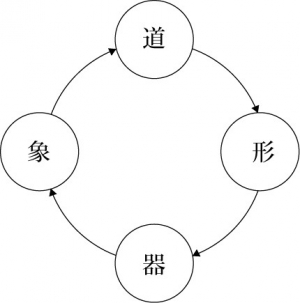
1. Solving Life Problems
Thecreation model often starts from "observation" of life. "Findinga problem and then solving the problem" can be the origin of design.However, there are many problems found in daily life, but the real test of thedesigner’s ability is the problem-solving skill. How can I make the design workgiven a "Wow, that’s it!" moment, is a very difficult challenge. Forexample, the work "Tilt Cup" (Fig. 2) by Huang, Shi-Hao attempts tosolve a problem often encountered daily. Mr. Huang had observed that when a cup(or glass) is placed upside down after cleaning, the remaining water dropletseasily cause bacteria to breed because the air inside can not flow out;however, if the cup is placed upright, dust easily falls into it. It is usuallynecessary to use a "cup holder" to store the cup after cleaning toallow air to flow in and out. The solution of "Tilt Cup" is makingthe rim of the cup at an oblique angle, so when the cup is placed upside down,air can still flow internally. This design solves the problem of sanitation andeliminates the need for cup holders, is easy to manufacture with no additionalcosts, and because of the clever problem-solving skill involved and its veryproductive value, it was awarded the American IDEA Design Bronze Prize Award.

Thework "Zipper Lock" (Fig. 3) by Ke, Chih-Teng and Shih, Chang-Chi wonthe Red Dot Best of the Best Award for Design Concept. It combines a"zipper" and a "lock" together. The concept had beengenerated in a work camp of locks. The students constantly modified theirdesign; not only making it more beautiful in shape, but also following theconcept of universal design, making it easy to operate intuitively.
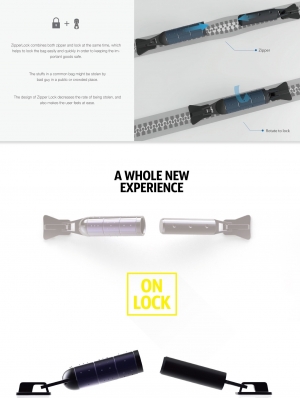
2. Culture Exists in Reality and EvenMore in the Future
Whenmany people talk about culture, they always think of tradition and history, asif many years are needed in order to see the depth of culture. In fact, cultureexists in daily life, and exists even more in regional fields. Through fieldresearch, observing regional lands and populations is also an important work ofa designer. The work "Mr. Fish" (Fig. 4) by Lin, Min-Yi and Li,Rih-Yan, which won the Red Dot Award for Design Concept, is an excellentexpression of this concept. The student designers visited several fishing portsin northern Taiwan many times in the early period of concept development. Theyunderstood the procedures of transporting, processing, displaying, etc. of fishproducts for sale after the fishing boats had returned back to the ports. Theyanalyzed the problems in detail and then developed a systematically completedesign; the overall system included the design of a fish transport-storage box,a fish bench, a display table that can keep cold, and the consideration ofwaste disposal.
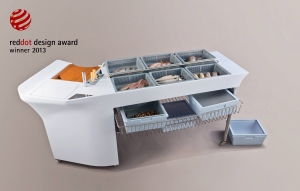
Anotherwork, the tea set "TASTING SANXIA" (Fig. 5) by Shih, Chang-Chi andCiou, Han-Sheng was created from the idea of the blue dye of Sanxia and the teaculture of Biluochun. The teapot base and saucer were made of bamboo dyed withblue color; the teapot and cups were shaped like drops; and there is anintersection of three springs in the image of "Sanjiaoyung" (TriangleGush), the ancient name of Sanxia. This modern style tea set abandons visiblesymbols, but shows cultural atmosphere in a more subtle way. This work has wonthe honorable mention of the Taiwan OTOP Design Award. Its creative process andwork have been published in a paper for the conference of Japanese Society forthe Science of Design (JSSD) and have won the Best Presentation Award.
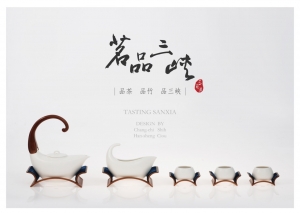
Thework "MAJAN" (Fig. 6-1 & Fig. 6-2) by Tan, Yu-Chen and Ke,Chih-Teng won the Red Dot Best of the Best Award for Design Concept. The studentdesigners found that the attitude of foreigners to mahjong was very differentcompared to local views of mahjong. They then explored the topics of mahjong,and let it become the source of their thematic creation. They rediscovered andrepackaged mahjong culture in furniture design, so that a mahjong table canbecome a regular table when not playing mahjong, thus not wasting any space. Inaddition, the mahjong table was re-designed with more modern images includingEnglish text. Their goal was to make it easier for foreigners to understandmahjong culture and to participate. Through the "MAJAN," the mahjongculture is continually extended, not only focusing on local Taiwanese culturebut also stepping into internationalization.
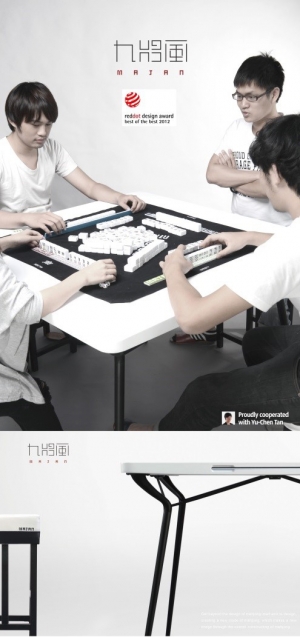

3. Understanding Students’Characteristics and Acting Freely
Inthe process of design development, I have been constantly making the lateral(divergent) and vertical (convergence) thinkings, and gradually modifying theworks. The characteristics of each student I instructed are different; forexample, I view Huang, Shi-Hau, Tan, Yu Chen, and Li, Rih-Yan to be stronger inlateral thinking, Ciou, Han-Sheng, and Shih, Chang-Chi stronger in verticalthinking, and Ke, Chih-Teng and Lin, Min-Yi strong at both lateral and verticalthinkings. When a team is being assembled, the best combination in my view isstudents strong in one skill (thinking) properly matched with students strongin the opposite skill. When two divergent thinkers are teamed together, theirdesign usually stays in the concept stage; when two vertical thinkers aretogether, their work is usually conservative and without highlights. Therefore,I had to understand the characteristics of each student and guide them to aspecialty, and strengthen their lacking characteristics.
Ithink in addition to being more active, a society that encourages creativityand innovation can better promote the flow of industries. Take the USA forexample, where innovation and entrepreneurship are encouraged. When Kodak,General Motors, and other companies of traditional industries were facingdifficulties, emerging industries such as Google, Facebook, etc. arose tosupport the overall industrial environment. We are in an age with a rapid flowof information, and our lives are full of excess consumer products. It isdifficult to find a product selling for 10 years or longer. What we shouldthink of is how to lead the growth of the entire society through the creativeideas of designers. Take industrial designers for example, whose profession isa mix of engineering and art; they understand manufacturing, but they also needto learn aesthetics and marketing. If they can use their specialties, they willnot be only designers, but also entrepreneurs with the ability of integrationand innovation. It is very pleasing that currently many areas are activelypromoting entrepreneurship plans and subsidies. It is also very pleasing thatIDC also actively guides people to creative practice. We believe thatdesigners’ innovations transformed into strongly integrated enterprisingpractices help to promote the development of industries, which is also thesocial responsibility of designers. As creators in ancient times were regardedas saints, Tim Brown also believes that design thinking can change the world,meaning that design can be greatly influential. After success in the ITindustry in recent years, Taiwanese society is constantly looking for renewableindustries. Design is a profession belonging to creativity. Winning prizes andideas in design competitions, and transforming these ideas into industrialentrepreneurial models, are part of the cultural and creative industries aswell as the show of Taiwan's soft power. Designers should not only locatethemselves in the position of designers, they also need more courage to crossborders and change the industry environment through entrepreneurship, enhancingthe influence of design.